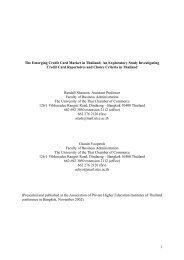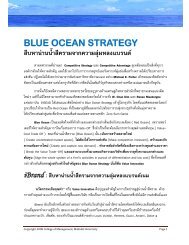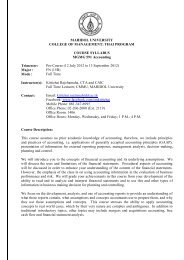Comparative Analysis of Values and Shopping Patterns Among ...
Comparative Analysis of Values and Shopping Patterns Among ...
Comparative Analysis of Values and Shopping Patterns Among ...
You also want an ePaper? Increase the reach of your titles
YUMPU automatically turns print PDFs into web optimized ePapers that Google loves.
Page 6 <strong>of</strong> 11 <br />
given their unique characteristics, which are structurally different from traditional<br />
shopping venues. A shopping mall is usually characterized with a large amount <strong>of</strong> stores<br />
<strong>and</strong> entertainment facilities <strong>and</strong> presents substantial variety <strong>and</strong> selection <strong>of</strong> products <strong>and</strong><br />
services with pleasant atmosphere (Nicholls et al., 2003). The discrepancy in the mall<br />
development history may imply that Thai shoppers may have shaped themselves as<br />
modern shoppers in the mall to shop for fulfilling diverse needs rather than purchase<br />
alone. It may also be that Thais are more active shoppers, in aggregate, than Chinese,<br />
leading to them giving higher scores for both utilitarian <strong>and</strong> hedonic motivations. The<br />
issue may further be confounded by a consumer’s underlying reason for shopping, as a<br />
shopping trip one day might be viewed as work, while another day a trip to the same<br />
location could be viewed as leisure. It should be noted that the utilitarian construct did<br />
not achieve a high reliability score.<br />
Retailers should be aware that differences in consumer behavior may exist across<br />
cultures, especially when exp<strong>and</strong>ing into markets other than their own. Knowing that a<br />
consumer has more utilitarian motivations may lead to a retailer to adjust the layout <strong>and</strong><br />
flow <strong>of</strong> a mall or merch<strong>and</strong>ise, adjust the amount <strong>of</strong> information or even comparative<br />
information displayed or shared with consumers, or perhaps the importance <strong>of</strong><br />
knowledgeable salespeople.<br />
Future research could further explore hedonistic <strong>and</strong> utilitarian shopping motives <strong>and</strong><br />
actual outcomes, to investigate differences in time <strong>and</strong> money spent, number <strong>of</strong><br />
companions, <strong>and</strong> perhaps price or value consciousness. It is possible that the constructs<br />
used for measuring hedonistic <strong>and</strong> utilitarian motivations may require additional<br />
interpretation. A highly utilitarian shopper may derive hedonistic enjoyment from<br />
comparing prices or obtaining a good deal. It may also be worth exploring potential<br />
differences between groups based on age <strong>and</strong> education, or other psychographic<br />
variables.

















